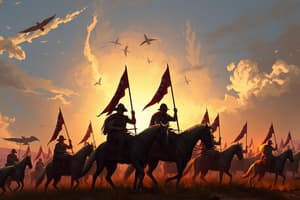Podcast
Questions and Answers
What does identical mtDNA across nine individuals in Pueblo Bonito indicate?
What does identical mtDNA across nine individuals in Pueblo Bonito indicate?
- Matrilineal lineage (correct)
- Nuclear family relationships
- Genetic mutations over time
- Cultural diversity among the population
The study found that the matriline persisted for approximately 200 years.
The study found that the matriline persisted for approximately 200 years.
False (B)
What significant items were found in the burial of male 14?
What significant items were found in the burial of male 14?
Elite grave goods such as turquoise and shells.
Under the Native American Graves Protection and Repatriation Act, the law was established in _____.
Under the Native American Graves Protection and Repatriation Act, the law was established in _____.
Match the archaeological features with their significance:
Match the archaeological features with their significance:
What was one ethical concern raised by Ruth Van Dyke regarding the analysis of Indigenous remains?
What was one ethical concern raised by Ruth Van Dyke regarding the analysis of Indigenous remains?
The 2000 decision by the AMNH was to consult tribes about the cultural affiliation of the remains.
The 2000 decision by the AMNH was to consult tribes about the cultural affiliation of the remains.
What is the primary focus of the 2017 aDNA Study in Pueblo Bonito?
What is the primary focus of the 2017 aDNA Study in Pueblo Bonito?
Flashcards
Ancient DNA study, Pueblo Bonito
Ancient DNA study, Pueblo Bonito
Analysis of ancient DNA from burials at Pueblo Bonito, Chaco Canyon, to understand lineage and leadership.
Matrilineal Lineage
Matrilineal Lineage
A kinship system where descent and inheritance are traced through the mother's line.
Pueblo Bonito elite
Pueblo Bonito elite
Leaders of Pueblo Bonito, possibly inherited power through a matriline.
NAGPRA
NAGPRA
Signup and view all the flashcards
14C dating
14C dating
Signup and view all the flashcards
Hereditary leadership Chaco
Hereditary leadership Chaco
Signup and view all the flashcards
Kennewick Man Case
Kennewick Man Case
Signup and view all the flashcards
Ethical Concerns in Archaeology
Ethical Concerns in Archaeology
Signup and view all the flashcards
Study Notes
Chaco Culture National Historical Park
- Located in Chaco Canyon, New Mexico
- Ancient Puebloan peoples lived there
- Significant archaeological site
- Map depicts the location of the park in relation to other geographical features
Chaco Canyon Matrilineal Dynasty
- Ancient DNA and 14C dating analyses of burials in Pueblo Bonito
- Nine individuals had identical mtDNA, indicating a matrilineal lineage
- Evidence of mother-daughter and grandmother-grandson relationships
- Elite matriline persisted for approximately 330 years (AD 800–1130)
- Burials contained elite grave goods, like turquoise and shells
Ethical Concerns in Archaeological Research
- Ethical concerns surrounding the study of ancient DNA from Indigenous human remains
- Scientists need to collaborate with Native peoples before conducting such research
- Preserving cultural heritage is equally important as scientific advancements of archeological findings
- The recent case suggests more sensitivity and respect is urgently needed
- The time for simply studying ancient human remains without tribal engagement has passed.
- This is a decision, not a lack of awareness.
NAGPRA (Native American Graves Protection and Repatriation Act)
- 1990 law, applicable to federally owned land
- Chaco is a National Park, making it subject to NAGPRA
- The American Museum of Natural History (AMNH) is a federally supported institution
- AMNH, in 2000, could not determine which tribe was a lineal descendant
- Consequently, no tribes were consulted in relation to the findings
Kennewick Man
- Discovered in the Columbia River (Washington)
- Approximately 9,000 years old
- Local groups claim the remains under the NAGPRA
- Lawsuit by scientists over the remains was successful
- DNA study determined Kennewick Man was Native American
- The remains were returned to tribes and reburied in a secret location
Kurt Dongoske's Perspective
- Archaeologist for the Zuni Pueblo
- Argued that Native peoples already possess their heritage through indigenous oral history, ceremonies, and prayers
- Contends that claiming science as the only path to understanding the past is insulting to Indigenous communities
- Colonialism's effects are perpetuated when science is not mindful of preserving heritage
Eske Willerslev's Perspective
- Emphasized the need for tribal engagement in ancient DNA studies of human remains
- Many tribes consider human remains as ancestors, regardless of genetic or cultural links
- Ignoring tribal consultation is a conscious decision, and not lacking awareness.
Studying That Suits You
Use AI to generate personalized quizzes and flashcards to suit your learning preferences.




